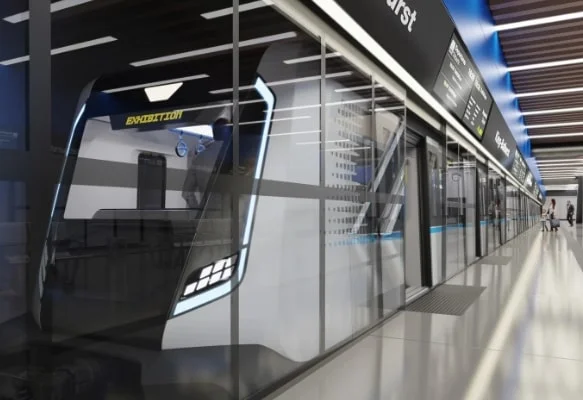23 October 2013
Tokyo, October 23, 2013 --- Hitachi, Ltd. (TSE: 6501 / “Hitachi”) today announced that it has decided to transfer its elevator and escalator business in Japan and integrate it with Hitachi Building Systems Co., Ltd. (“Hitachi Building Systems”), a wholly owned subsidiary, on April 1, 2014. The purpose of this restructuring is to strengthen and expand the elevator and escalator business in Japan.
Specifically, Hitachi will use a company split to transfer the design, manufacturing and sales divisions related to elevator and escalator business in Japan operated by Hitachi in-house company Urban Planning and Development Systems Company to Hitachi Building Systems, which handles sales, installation, maintenance and refurbishment. The Urban Planning and Development Systems Company will now focus on global corporate functions and development oversight functions in the elevator and escalator business, while the respective businesses in Japan, China and Asia will be conducted by Hitachi Building Systems, Hitachi Elevator (China) Co., Ltd. (“Hitachi Elevator (China)”) and Hitachi Elevator Asia Pte. Ltd. (“Hitachi Elevator Asia”) as regional headquarters.
Certain disclosures and details have been omitted as this transaction is a company split transferring businesses from Hitachi to its wholly owned subsidiary.
1. Purpose of Company Split
The global elevator and escalator market is forecast to see higher demand going forward, particularly in emerging markets such as China and India, which account for approximately 60% of demand for new elevators and escalators. Hitachi established Hitachi Elevator (China) in 1995 in Guangzhou, Guangdong, China, and Hitachi Elevator Asia in 2010 in Singapore as the regional headquarters for China and Asia respectively, and is working to expand business globally in this field. Recently, Hitachi has been promoting the standardization of production management systems, which were different in each country and region, as well as strengthening manufacturing globally. Meanwhile, in Japan Hitachi’s Urban Planning and Development Systems Company, which is responsible for the development, design, manufacture and sale of elevators and escalators, has been working to develop business with Hitachi Building Systems, which handles sales, installation, maintenance and refurbishment. Amid lackluster demand for new elevators and escalators in Japan in recent years, Hitachi has been taking steps to strengthen the refurbishment business, since there are an increasing number of elevators and escalators due for modernization.
In addition, Hitachi is concentrating on the Social Innovation Business, which aims to provide IT-enhanced social infrastructure on a global basis. At the same time, Hitachi is working to improve the efficiency and speed of fundamental tasks and decision-making through the Hitachi Smart Transformation Project, with the goal of transforming Hitachi into a global major player. Recently, Hitachi has been pushing ahead with efforts to create a simpler, highly functional organization that focuses on strategy formulation and implementation, and on making proposals and providing support to executives. The aim is for Group Corporate divisions to drive Hitachi Group activities for promoting the Social Innovation Business.
Through this company split, Hitachi will transfer the design, manufacturing and sales divisions related to elevators and escalators of the Urban Planning and Development Systems Company to Hitachi Building Systems to realize integrated management. In this way, Hitachi will be able to provide one-stop solutions extending from manufacturing to sales and services. Moreover, this move is intended to optimize management resources and increase cost competitiveness. At the same time, by strengthening the refurbishment business, which is expected to see higher demand going forward, Hitachi aims to expand and reinforce the elevator and escalator business in Japan. Meanwhile, the Urban Planning and Development Systems Company will focus on global corporate functions, including global business oversight of the elevator and escalator business, and development oversight. By supporting regional headquarters for Japan, China and Asia and strengthening governance, this in-house company will develop global strategy models and promote overall optimization of manufacturing, thereby expanding business.
2. Outline of Company Split
(1) Company Split Schedule
Execution of Company Split Agreement | January 2014 (Tentative) |
Scheduled Company Split Date (Effective Date) | April 1, 2014 (Tentative) |
(Note) The company split is deemed to be a simple absorption-type company split, pursuant to Article 784, Paragraph 3 of the Companies Act of Japan. Therefore, Hitachi does not plan to convene a shareholders’ meeting to obtain approval for the company split agreement.
(2) Company Split Method
This is an absorption-type split in which Hitachi is the transferring company and Hitachi Building Systems is the successor company.
(3) Handling of Stock Acquisition Rights and Bonds with Stock Acquisition Rights Accompanying the Company Split
Hitachi has no outstanding stock acquisition rights or bonds with stock acquisition rights.
(4) Capitalization Changes Accompanying the Company Split
The company split will result in no change in capitalization of Hitachi.
(5) Others
Other details of the company split will be announced when they are determined.
3. Profile of the Parties of the Company Split
. | Transferring Company | Successor Company |
(1) Name | Hitachi, Ltd. | Hitachi Building Systems Co., Ltd. |
(2) Head Office | 6-6, Marunouchi 1-Chome, Chiyoda-ku, Tokyo | 2-101, Kandaawajicho, Chiyoda-ku, Tokyo |
(3) Representative | Hiroaki Nakanishi, President | Eiichi Sasaki, President |
(4) Business | Development, manufacture and sales of products and provision of service across 10 segments: Information & Telecommunication Systems, Power Systems, Social Infrastructure & Industrial Systems, Electronic Systems & Equipment, Construction Machinery, High Functional Materials & Components, Automotive Systems, Digital Media & Consumer Products, Others (Logistics and Other services) and Financial Services | ・Sale, installation, maintenance, reform and repair, renewal and design of elevators, escalators ・Monitoring and control of building facilities, building management, etc. |
(5) Capital | 458,790 million yen (As of March 31, 2013) | 5,105 million yen (As of March 31, 2013) |
(6) Established | February 1, 1920 | October 1, 1956 |
(7) Number of issued shares | 4,833,463,387 (As of March 31, 2013) | 10,210,182 (As of March 31, 2013) |
(8) Fiscal year-end | March 31 | March 31 |
(9) Major shareholders and shareholding | The Master Trust Bank of Japan, Ltd. (Trust Account) 6.52% Japan Trustee Services Bank, Ltd. (Trust Account) 5.77% SSBT OD05 OMNIBUS ACCOUNT TREATY CLIENTS 2.58% Hitachi Employees’ Shareholding Association 2.57% State Street Bank and Trust Company 505224 2.18% (As of March 31, 2013) | Hitachi, Ltd. 100% |
(10) Financial conditions and business results for the most recent fiscal year (Millions of yen unless otherwise specified) | ||
Net assets | 3,179,287 (Consolidated) | 77,619 (Unconsolidated) |
Total assets | 9,809,230 (Consolidated) | 224,670 (Unconsolidated) |
Net assets per share (yen)*1 | 431.13 (Consolidated) | 7,602.20 (Unconsolidated) |
Revenues | 9,041,071 (Consolidated) | 241,093 (Unconsolidated) |
Operating income | 422,028 (Consolidated) | 19,524 (Unconsolidated) |
Ordinary income*2 | 344,537 (Consolidated) | 20,595 (Unconsolidated) |
Net income*3 | 175,326 (Consolidated) | 11,570 (Unconsolidated) |
Net income per share (yen)*3 | 37.28 (Consolidated) | 1,133.22 (Unconsolidated) |
*1 Since Hitachi has been adopting U.S. accounting standards, this figure represents stockholders’ equity per share.
*2 Since Hitachi has been adopting U.S. accounting standards, this figure represents income before income taxes.
*3 Since Hitachi has been adopting U.S. accounting standards, these figures represent net income attributable to Hitachi, Ltd. stockholders and net income attributable to Hitachi, Ltd. stockholders per share basic, respectively.
4. Overview of the Business to Be Transferred
(1) Business of the Business to Be Transferred
Design, manufacture, sale, etc. related to elevator and escalator business in Japan.
(2) Others
Other details concerning the business to be transferred will be announced as they are decided.
5. Status of Succeeding Company After Transfer
(1) Name | Hitachi Building Systems Co., Ltd. |
(2) Head Office | 2-101, Kandaawajicho, Chiyoda-ku, Tokyo |
(3) Representative | Eiichi Sasaki, President |
(4) Business | ・Manufacture, sale, installation, maintenance, reform and repair, renewal and design of elevators, escalators ・Monitoring and control of building facilities, building management, etc. |
(5) Capital | (Not yet determined) |
(6) Fiscal year-end | March 31 |
6. Status of Hitachi After the Company Split
There will be no change in the company name, head office location, representative’s position or name, business activities, capital or fiscal year of Hitachi due to the company split.
7. Outlook
The company split will have no impact on the consolidated operating results of Hitachi.
(Reference) Consolidated Business Forecasts for the Year Ending March 31, 2014 (announced on October 23, 2013) and Consolidated Operating Results for the Previous Fiscal Year
(Millions of yen)
. | Revenues | Operating Income | Income Before Income Taxes | Net Income Attributable to Hitachi, Ltd. Stockholders |
Consolidated Business Forecasts for Fiscal 2013 (Year ending March 31, 2014) | 9,200,000 | 500,000 | 425,000 | 210,000 |
Consolidated Operating Results for Fiscal 2012 (Year ended March 31, 2013) | 9,041,071 | 422,028 | 344,537 | 175,326 |
About Hitachi, Ltd.
Hitachi, Ltd. (TSE: 6501), headquartered in Tokyo, Japan, is a leading global electronics company with approximately 326,000 employees worldwide. The company’s consolidated revenues for fiscal 2012 (ended March 31, 2013) totaled 9,041 billion yen ($96.1 billion). Hitachi is focusing more than ever on the Social Innovation Business, which includes infrastructure systems, information & telecommunication systems, power systems, construction machinery, high functional material & components, automotive systems and others. For more information on Hitachi, please visit the company’s website at http://www.hitachi.com.
Cautionary Statement
Certain statements found in this document may constitute “forward-looking statements” as defined in the U.S. Private Securities Litigation Reform Act of 1995. Such “forward-looking statements” reflect management’s current views with respect to certain future events and financial performance and include any statement that does not directly relate to any historical or current fact. Words such as “anticipate,” “believe,” “expect,” “estimate,” “forecast,” “intend,” “plan,” “project” and similar expressions which indicate future events and trends may identify “forward-looking statements.” Such statements are based on currently available information and are subject to various risks and uncertainties that could cause actual results to differ materially from those projected or implied in the “forward-looking statements” and from historical trends. Certain “forward-looking statements” are based upon current assumptions of future events which may not prove to be accurate. Undue reliance should not be placed on “forward-looking statements,” as such statements speak only as of the date of this document.
Factors that could cause actual results to differ materially from those projected or implied in any “forward-looking statement” and from historical trends include, but are not limited to:
• economic conditions, including consumer spending and plant and equipment investment in Hitachi’s major markets, particularly Japan, Asia, the United States and Europe, as well as levels of demand in the major industrial sectors Hitachi serves, including, without limitation, the information, electronics, automotive, construction and financial sectors;
• exchange rate fluctuations of the yen against other currencies in which Hitachi makes significant sales or in which Hitachi’s assets and liabilities are denominated, particularly against the U.S. dollar and the euro;
• uncertainty as to Hitachi’s ability to access, or access on favorable terms, liquidity or long-term financing;
• uncertainty as to general market price levels for equity securities, declines in which may require Hitachi to write down equity securities that it holds;
• the potential for significant losses on Hitachi’s investments in equity method affiliates;
• increased commoditization of information technology products and digital media-related products and intensifying price competition for such products, particularly in the Digital Media & Consumer Products segment;
• uncertainty as to Hitachi’s ability to continue to develop and market products that incorporate new technologies on a timely and cost-effective basis and to achieve market acceptance for such products;
• rapid technological innovation;
• the possibility of cost fluctuations during the lifetime of, or cancellation of, long-term contracts for which Hitachi uses the percentage-of-completion method to recognize revenue from sales;
• fluctuations in the price of raw materials including, without limitation, petroleum and other materials, such as copper, steel, aluminum, synthetic resins, rare metals and rare-earth minerals, or shortages of materials, parts and components;
• fluctuations in product demand and industry capacity;
• uncertainty as to Hitachi’s ability to implement measures to reduce the potential negative impact of fluctuations in product demand, exchange rates and/or price of raw materials or shortages of materials, parts and components;
• uncertainty as to Hitachi’s ability to achieve the anticipated benefits of its strategy to strengthen its Social Innovation Business;
• uncertainty as to the success of restructuring efforts to improve management efficiency by divesting or otherwise exiting underperforming businesses and to strengthen competitiveness;
• uncertainty as to the success of cost reduction measures;
• general socioeconomic and political conditions and the regulatory and trade environment of countries where Hitachi conducts business, particularly Japan, Asia, the United States and Europe, including, without limitation, direct or indirect restrictions by other nations on imports and differences in commercial and business customs including, without limitation, contract terms and conditions and labor relations;
• uncertainty as to the success of alliances upon which Hitachi depends, some of which Hitachi may not control, with other corporations in the design and development of certain key products;
• uncertainty as to Hitachi’s access to, or ability to protect, certain intellectual property rights, particularly those related to electronics and data processing technologies;
• uncertainty as to the outcome of litigation, regulatory investigations and other legal proceedings of which the Company, its subsidiaries or its equity method affiliates have become or may become parties;
• the possibility of incurring expenses resulting from any defects in products or services of Hitachi;
• the possibility of disruption of Hitachi’s operations by earthquakes, tsunamis or other natural disasters;
• uncertainty as to Hitachi’s ability to maintain the integrity of its information systems, as well as Hitachi’s ability to protect its confidential information or that of its customers;
• uncertainty as to the accuracy of key assumptions Hitachi uses to evaluate its significant employee benefit-related costs; and
• uncertainty as to Hitachi’s ability to attract and retain skilled personnel.
The factors listed above are not all-inclusive and are in addition to other factors contained in other materials published by Hitachi.
Contacts
Japan
Katsunori Shimokawara
Hitachi, Ltd.
+81-3-5208-9325
katsunori.shimokawara.zs@hitachi.com
U.S.A.
Mickey Takeuchi
Hitachi America, Ltd.
+1-914-333-2987
Hitachi in Canada
At Hitachi, green and digital innovation drives our mission as climate change innovators. Converging operational and information technologies, Hitachi is addressing societal and environmental challenges, shaping a greener, brighter tomorrow for all.







